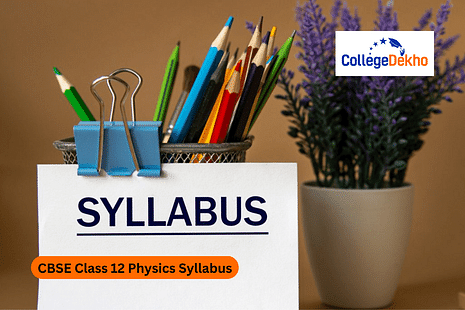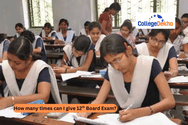CBSE Class 12 Physics Syllabus 2026 can be accessed on the official website of CBSE Academics. The theory paper in Physics will be conducted for 70 marks.


Never Miss an Exam Update
CBSE Class 12 Physics Syllabus 2026 has been released on the official website of CBSE Academics at cbseacademic.nic.in. The theory paper will be conducted for 70 marks. 30 marks will be provided for the practical. There are 14 chapters included in the syllabus. These chapters are grouped into different units. A total of 9 units are included in the subject. Electromagnetic waves and Optics have the most amount of weightage in the syllabus. You must complete the syllabus beforehand to practice the CBSE Class 12 Physics Sample Paper 2026 .
CBSE 12th board exams 2026 will start from February 15, 2026. The direct PDF for the syllabus is now uploaded on the official website of CBSE Academics to be downloaded. You are required to score 33% marks to successfully pass the exams. You must also solve the CBSE Class 12 Physics Previous Year Question Paper for better preparation. Check more information about the CBSE Syllabus for Class 12 Physics 2026 here .
Also Read: CBSE Class 12 Physics Exam Pattern 2026
CBSE Syllabus for Class 12 Physics 2026 PDF
The PDF for the CBSE 12th Physics syllabus is now available on the official website of CBSE Academics. You can download the PDF for the syllabus from the direct links given below:
| CBSE Class 12 Physics Syllabus 2026 PDF |
|---|
CBSE Class 12 Physics Exam Pattern 2026
Check the detailed CBSE Class 12 Physics Exam Pattern 2026 below:
Name of the Unit | Name of the Chapter | Total Number of Marks |
|---|---|---|
Electrostatics | Electric Charges and Fields | 16 |
Electrostatic Potential and Capacitance | ||
Current Electricity | Current Electricity | |
Magnetic Effects of Current and Magnetism | Moving Charges and Magnetism | 17 |
Magnetism and Matter | ||
Electromagnetic Induction and Alternating Currents | Electromagnetic Induction | |
Alternating currents | ||
Electromagnetic Waves | Electromagnetic Waves | 18 |
Optics | Ray Optics and Optical Instruments | |
Wave Optics | ||
Dual Nature of Radiation and Matter | Dual Nature of Radiation and Matter | 12 |
Atoms and Nuclei | Atoms | |
Nuclei | ||
| Electronic Devices | Semiconductor -Electronics: Materials, Devices, and Simple Circuits | 7 |
Also read: CBSE Class 12 Date Sheet 2026
CBSE Syllabus for Class 12 Physics 2026
There are a lot of chapters included in the Physics subject. You can check out the information about the detailed topics in each chapter from the table given below:
Name of the Chapter | Topics |
|---|---|
Electric Charges and Fields | Electric charges, Conservation of charge, Coulomb's law-force between two- point charges, forces between multiple charges; superposition principle, and continuous charge distribution. Electric field, electric field due to a point charge, electric field lines, electric dipole, electric field due to a dipole, torque on a dipole in the uniform electric field. Electric flux, statement of Gauss's theorem and its applications to find field due to infinitely long straight wire, uniformly charged infinite plane sheet, and uniformly charged thin spherical shell (field inside and outside). |
Electrostatic Potential and Capacitance | Electric potential, potential difference, electric potential due to a point charge, a dipole, and system of charges; equipotential surfaces, electrical potential energy of a system of two point charges and of electric dipole in an electrostatic field. Conductors and insulators, free charges, and bound charges inside a conductor. Dielectrics and electric polarization, capacitors, and capacitance, combination of capacitors in series and in parallel, capacitance of a parallel plate capacitor with and without dielectric medium between the plates, energy stored in a capacitor (no derivation, formulae only). |
Current Electricity | Electric current, flow of electric charges in a metallic conductor, drift velocity, mobility and their relation with electric current; Ohm's law, V-I characteristics (linear and non-linear), electrical energy and power, electrical resistivity and conductivity, temperature dependence of resistance, Internal resistance of a cell, potential difference and emf of a cell, combination of cells in series and in parallel, Kirchhoff's rules, Wheatstone bridge. |
Moving Charges and Magnetism | Concept of magnetic field, Oersted's experiment. Biot - Savart law and its application to current carrying circular loop. Ampere's law and its applications to infinitely long straight wire. Straight solenoid (only qualitative treatment), force on a moving charge in uniform magnetic and electric fields. Force on a current-carrying conductor in a uniform magnetic field, force between two parallel current-carrying conductors-definition of ampere, torque experienced by a current loop in uniform magnetic field; Current loop as a magnetic dipole and its magnetic dipole moment, moving coil galvanometer- its current sensitivity and conversion to ammeter and voltmeter |
Magnetism and Matter | Bar magnet, bar magnet as an equivalent solenoid (qualitative treatment only), magnetic field intensity due to a magnetic dipole (bar magnet) along its axis and perpendicular to its axis (qualitative treatment only), torque on a magnetic dipole (bar magnet) in a uniform magnetic field (qualitative treatment only), magnetic field lines. Magnetic properties of materials- Para-, dia- and ferro - magnetic substances with examples, Magnetization of materials, effect of temperature on magnetic properties |
Electromagnetic Induction | Electromagnetic induction; Faraday's laws, induced EMF and current; Lenz's Law, Self and mutual induction. |
Alternating currents | Alternating currents, peak and RMS value of alternating current/voltage; reactance and impedance; LCR series circuit (phasors only), resonance, power in AC circuits, power factor, wattless current. AC generator, Transformer |
Electromagnetic Waves | Basic idea of displacement current, Electromagnetic waves, their characteristics, and their transverse nature (qualitative idea only). Electromagnetic spectrum (radio waves, microwaves, infrared, visible, ultraviolet, X-rays, gamma rays) including elementary facts about their uses. |
Ray Optics and Optical Instruments | Ray Optics: Reflection of light, spherical mirrors, mirror formula, refraction of light, total internal reflection and optical fibers, refraction at spherical surfaces, lenses, thin lens formula, lens maker’s formula, magnification, power of a lens, a combination of thin lenses in contact, refraction of light through a prism. Optical instruments: Microscopes and astronomical telescopes (reflecting and refracting) and their magnifying powers. |
Wave Optics | Wave optics: Wave front and Huygens principle, reflection and refraction of plane wave at a plane surface using wave fronts. Proof of laws of reflection and refraction using Huygens principle. Interference, Young's double slit experiment and expression for fringe width (No derivation final expression only), coherent sources and sustained interference of light, diffraction due to a single slit, and width of central maxima (qualitative treatment only). |
Dual Nature of Radiation and Matter | Dual nature of radiation, Photoelectric effect, Hertz and Lenard's observations; Einstein's photoelectric equation-particle nature of light. Experimental study of photoelectric effect Matter waves-wave nature of particles, de-Broglie relation |
Atoms | Alpha-particle scattering experiment; Rutherford's model of atom; Bohr model of hydrogen atom, Expression for radius of the nth possible orbit, velocity and energy of electron in nth orbit, hydrogen line spectra (qualitative treatment only). |
Nuclei | Composition and size of nucleus, nuclear force Mass-energy relation, mass defect; binding energy per nucleon and its variation with mass number; nuclear fission, nuclear fusion. |
Semiconductor -Electronics: Materials, Devices, and Simple Circuits | Energy bands in conductors, semiconductors, and insulators (qualitative ideas only) Intrinsic and extrinsic semiconductors- p and n-type, p-n junction Semiconductor diode - I-V characteristics in forward and reverse bias, application of junction diode -diode as a rectifier. |
Also Check - CBSE Class 12 Syllabus 2026
CBSE Class 12 Physics Deleted Syllabus 2026
When preparing for the CBSE Class 12 Physics exam, you must check the syllabus in detail. The board has eliminated some topics. Go through the table below to ensure the CBSE Class 12 Physics Deleted Syllabus 2026 .
| Units | Chapters | Topics |
|---|---|---|
| Current Electricity | Chapter–3: Current Electricity | Electrical Resistance, Carbon resistors, colour code for carbon resistors; series and parallel combinations of resistors, metre bridge, Potentiometer - principle and its applications to measure potential difference and for comparing EMF of two cells; measurement of internal resistance of a cell |
| Magnetic Effects of Current and Magnetism | Chapter–4: Moving Charges and Magnetism | Cyclotron |
| Magnetic Effects of Current and Magnetism | Chapter–5: Magnetism and Matter | magnetic dipole moment of a revolving electron |
| Electromagnetic Induction and Alternating Currents | Chapter–6: Electromagnetic Induction | Eddy currents |
| Electromagnetic Induction and Alternating Currents | Chapter–7: Alternating Current | LC oscillations |
| Optics | Chapter–9: Ray Optics and Optical Instruments | Scattering of the light-blue colour of the sky and the reddish appearance of the sun at sunrise and sunset |
| Optics | Chapter–10: Wave Optics | resolving power of microscope and astronomical telescope, Polarisation, plane polarised light, Brewster's law, uses of plane polarised light and Polaroids |
| Dual Nature of Radiation and Matter | Chapter 11: Dual Nature of Radiation and Matter | Davisson-Germer experiment |
| Atoms and Nuclei | Chapter–13: Nuclei | Radioactivity, alpha, beta and gamma particles/rays and their properties; radioactive decay law. |
| Electronic Devices | Chapter–14: Semiconductor Electronics: Materials, Devices and Simple Circuits | Special purpose p-n junction diodes: LED, photodiode, solar cell and Zener diode and their characteristics, Zener diode as a voltage regulator |
CBSE Syllabus for Class 12 Physics 2026 is essential for the students. We have shared detailed information about the names of the units and the chapters included in each unit of the Physics subject here for the help of the students.
Are you feeling lost and unsure about what career path to take after completing 12th standard?
Say goodbye to confusion and hello to a bright future!

FAQs
Students can consider downloading the sample papers available on the official website of CBSE Academics in order to successfully revise the CBSE Syllabus for Class 12 Physics. You must at least have two months to complete your revision.
The topics included in the Electromagnetic induction chapter of the CBSE Syllabus for Class 12 Physics are Electromagnetic induction, Faraday's laws, induced EMF and current; Lenz's Law, Self, and mutual induction.
The topics included in the Waves Optics chapter of the CBSE Syllabus for Class 12 Physics are Wave optics: Wave front and Huygens principle, reflection, and refraction of plane wave at a plane surface using wave fronts. Proof of laws of reflection and refraction using Huygens principle. Interference, Young's double slit experiment and expression for fringe width (No derivation final expression only), coherent sources and sustained interference of light, diffraction due to a single slit, and width of central maxima (qualitative treatment only).
To complete the CBSE Syllabus for Class 12 Physics, students must focus on planning their study according to the number of topics in the board exams. Make sure to allot time on each topic and revise accordingly.
The topics included in the Electromagnetic Waves chapter of the CBSE Syllabus for Class 12 Physics are the Basic idea of displacement current, Electromagnetic waves, their characteristics, and their transverse nature (qualitative idea only), Electromagnetic spectrum (radio waves, microwaves, infrared, visible, ultraviolet, X-rays, gamma rays) including elementary facts about their uses.
The most important subjects in CBSE Syllabus for Class 12 Physics are Electromagnetic Waves, Ray Optics, Optical Instruments, and Wave Optics. These three chapters combined hold the most amount of marks in the Physics subject.
Semiconductor -Electronics: Materials, Devices, and Simple Circuits holds the least amount of weightage in the CBSE Syllabus for Class 12 Physics. The total number of marks allotted for this chapter is 7.
The total marks for the Physics subject will be 70 marks. Students can prepare for the theory subject and the practical subject by considering the topics included in the CBSE Syllabus for Class 12 Physics.
The syllabus is the most important document because it helps the students to know more about the topics that will be coming in the board exams. You should download the CBSE Syllabus for Class 12 Physics to be familiar with the topic in the subject.
CBSE Syllabus for Class 12 Physics is listed on the official website of CBSE Academics to be downloaded in a PDF format. You just have to click on the curriculum option present on the menu bar in order to download the syllabus for different subjects.
Was this article helpful?

























